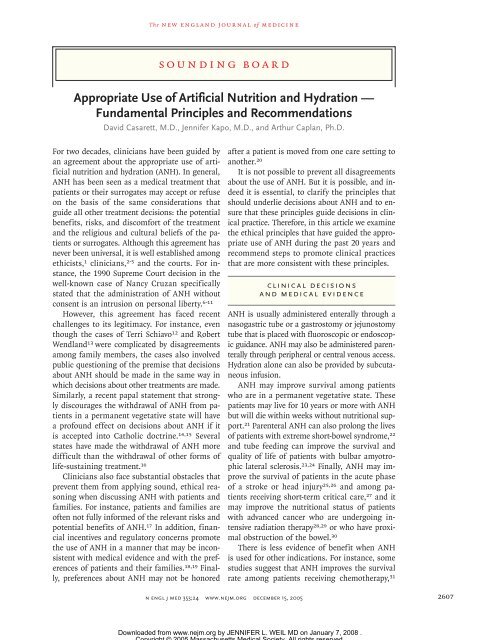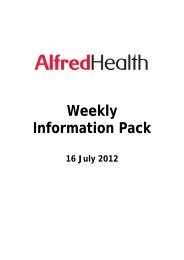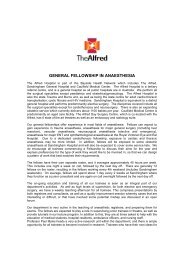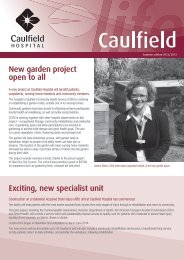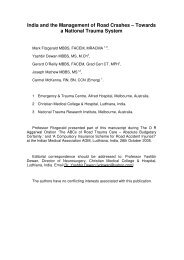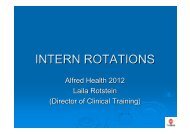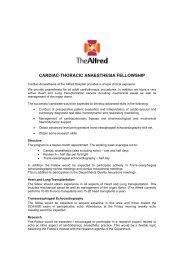Appropriate Use of Artificial Nutrition and Hydration — Fundamental ...
Appropriate Use of Artificial Nutrition and Hydration — Fundamental ...
Appropriate Use of Artificial Nutrition and Hydration — Fundamental ...
Create successful ePaper yourself
Turn your PDF publications into a flip-book with our unique Google optimized e-Paper software.
The new engl<strong>and</strong> journal <strong>of</strong> medicine<br />
sounding board<br />
<strong>Appropriate</strong> <strong>Use</strong> <strong>of</strong> <strong>Artificial</strong> <strong>Nutrition</strong> <strong>and</strong> <strong>Hydration</strong> <strong>—</strong><br />
<strong>Fundamental</strong> Principles <strong>and</strong> Recommendations<br />
David Casarett, M.D., Jennifer Kapo, M.D., <strong>and</strong> Arthur Caplan, Ph.D.<br />
For two decades, clinicians have been guided by<br />
an agreement about the appropriate use <strong>of</strong> artificial<br />
nutrition <strong>and</strong> hydration (ANH). In general,<br />
ANH has been seen as a medical treatment that<br />
patients or their surrogates may accept or refuse<br />
on the basis <strong>of</strong> the same considerations that<br />
guide all other treatment decisions: the potential<br />
benefits, risks, <strong>and</strong> discomfort <strong>of</strong> the treatment<br />
<strong>and</strong> the religious <strong>and</strong> cultural beliefs <strong>of</strong> the patients<br />
or surrogates. Although this agreement has<br />
never been universal, it is well established among<br />
ethicists, 1 clinicians, 2-5 <strong>and</strong> the courts. For instance,<br />
the 1990 Supreme Court decision in the<br />
well-known case <strong>of</strong> Nancy Cruzan specifically<br />
stated that the administration <strong>of</strong> ANH without<br />
consent is an intrusion on personal liberty. 6-11<br />
However, this agreement has faced recent<br />
challenges to its legitimacy. For instance, even<br />
though the cases <strong>of</strong> Terri Schiavo 12 <strong>and</strong> Robert<br />
Wendl<strong>and</strong> 13 were complicated by disagreements<br />
among family members, the cases also involved<br />
public questioning <strong>of</strong> the premise that decisions<br />
about ANH should be made in the same way in<br />
which decisions about other treatments are made.<br />
Similarly, a recent papal statement that strongly<br />
discourages the withdrawal <strong>of</strong> ANH from patients<br />
in a permanent vegetative state will have<br />
a pr<strong>of</strong>ound effect on decisions about ANH if it<br />
is accepted into Catholic doctrine. 14,15 Several<br />
states have made the withdrawal <strong>of</strong> ANH more<br />
difficult than the withdrawal <strong>of</strong> other forms <strong>of</strong><br />
life-sustaining treatment. 16<br />
Clinicians also face substantial obstacles that<br />
prevent them from applying sound, ethical reasoning<br />
when discussing ANH with patients <strong>and</strong><br />
families. For instance, patients <strong>and</strong> families are<br />
<strong>of</strong>ten not fully informed <strong>of</strong> the relevant risks <strong>and</strong><br />
potential benefits <strong>of</strong> ANH. 17 In addition, financial<br />
incentives <strong>and</strong> regulatory concerns promote<br />
the use <strong>of</strong> ANH in a manner that may be inconsistent<br />
with medical evidence <strong>and</strong> with the preferences<br />
<strong>of</strong> patients <strong>and</strong> their families. 18,19 Finally,<br />
preferences about ANH may not be honored<br />
after a patient is moved from one care setting to<br />
another. 20<br />
It is not possible to prevent all disagreements<br />
about the use <strong>of</strong> ANH. But it is possible, <strong>and</strong> indeed<br />
it is essential, to clarify the principles that<br />
should underlie decisions about ANH <strong>and</strong> to ensure<br />
that these principles guide decisions in clinical<br />
practice. Therefore, in this article we examine<br />
the ethical principles that have guided the appropriate<br />
use <strong>of</strong> ANH during the past 20 years <strong>and</strong><br />
recommend steps to promote clinical practices<br />
that are more consistent with these principles.<br />
clinical decisions<br />
<strong>and</strong> medical evidence<br />
ANH is usually administered enterally through a<br />
nasogastric tube or a gastrostomy or jejunostomy<br />
tube that is placed with fluoroscopic or endoscopic<br />
guidance. ANH may also be administered parenterally<br />
through peripheral or central venous access.<br />
<strong>Hydration</strong> alone can also be provided by subcutaneous<br />
infusion.<br />
ANH may improve survival among patients<br />
who are in a permanent vegetative state. These<br />
patients may live for 10 years or more with ANH<br />
but will die within weeks without nutritional support.<br />
21 Parenteral ANH can also prolong the lives<br />
<strong>of</strong> patients with extreme short-bowel syndrome, 22<br />
<strong>and</strong> tube feeding can improve the survival <strong>and</strong><br />
quality <strong>of</strong> life <strong>of</strong> patients with bulbar amyotrophic<br />
lateral sclerosis. 23,24 Finally, ANH may improve<br />
the survival <strong>of</strong> patients in the acute phase<br />
<strong>of</strong> a stroke or head injury 25,26 <strong>and</strong> among patients<br />
receiving short-term critical care, 27 <strong>and</strong> it<br />
may improve the nutritional status <strong>of</strong> patients<br />
with advanced cancer who are undergoing intensive<br />
radiation therapy 28,29 or who have proximal<br />
obstruction <strong>of</strong> the bowel. 30<br />
There is less evidence <strong>of</strong> benefit when ANH<br />
is used for other indications. For instance, some<br />
studies suggest that ANH improves the survival<br />
rate among patients receiving chemotherapy, 31<br />
n engl j med 353;24 www.nejm.org december 15, 2005 2607<br />
Downloaded from www.nejm.org by JENNIFER L. WEIL MD on January 7, 2008 .<br />
Copyright © 2005 Massachusetts Medical Society. All rights reserved.
The new engl<strong>and</strong> journal <strong>of</strong> medicine<br />
but other studies do not support this finding. 32,33<br />
Studies <strong>of</strong> the effect <strong>of</strong> ANH on complication<br />
rates after cancer surgery have also produced conflicting<br />
results. 34,35 The bulk <strong>of</strong> the available evidence<br />
suggests that ANH does not improve the<br />
survival rate among patients with dementia. 19,36-39<br />
ANH is associated with considerable risks. For<br />
instance, patients with advanced dementia who<br />
receive ANH through a gastrostomy tube are<br />
likely to be physically restrained <strong>and</strong> are at increased<br />
risk <strong>of</strong> aspiration pneumonia, diarrhea,<br />
gastrointestinal discomfort, <strong>and</strong> problems associated<br />
with feeding-tube removal by the patient.<br />
36,40-42 In addition, when a patient’s renal<br />
function declines in the last days <strong>of</strong> life, ANH<br />
may cause choking due to increased oral <strong>and</strong> pulmonary<br />
secretions, dyspnea due to pulmonary<br />
edema, <strong>and</strong> abdominal discomfort due to ascites.<br />
ethical principles<br />
for decision making<br />
Because ANH is associated with uncertain benefits<br />
<strong>and</strong> substantial risks, it is essential to ensure<br />
that decisions about its use are consistent with<br />
the patient’s medical condition, prognosis, <strong>and</strong><br />
goals for care. Therefore, decisions about ANH<br />
require careful consideration <strong>of</strong> its risks <strong>and</strong> potential<br />
benefits.<br />
Decisions about the use <strong>of</strong> ANH should be<br />
made in the same way in which decisions about<br />
other medical treatment are made. Many people<br />
believe that nutrition must always be <strong>of</strong>fered,<br />
just as pain management, shelter, <strong>and</strong> basic personal<br />
care must be. This view is deeply rooted<br />
in cultural <strong>and</strong> religious beliefs. 43 It is <strong>of</strong>ten<br />
expressed with the use <strong>of</strong> the word “starvation”<br />
14,43-45 to describe the condition <strong>of</strong> a patient<br />
who does not receive ANH. Patients, families,<br />
<strong>and</strong> physicians are entitled to hold these beliefs,<br />
which are not easily set aside. However, to help<br />
patients <strong>and</strong> families make decisions about ANH,<br />
physicians should present the contrary view by<br />
emphasizing three key points.<br />
First, physicians should emphasize that ANH<br />
is not a basic intervention that can be administered<br />
by anyone, as food is. ANH is a medical therapy<br />
administered for a medical indication (e.g.,<br />
dysphagia) with the use <strong>of</strong> devices that are placed<br />
by trained personnel using technical procedures.<br />
ANH therefore has more in common with other<br />
surgical <strong>and</strong> medical procedures that require technical<br />
expertise than with measures such as simple<br />
feeding. Second, physicians should explain that<br />
unlike the provision <strong>of</strong> food or other forms <strong>of</strong><br />
comfort (such as warmth or shelter), the procedures<br />
required for ANH <strong>and</strong> the subsequent<br />
administration <strong>of</strong> ANH are associated with uncertain<br />
benefits <strong>and</strong> considerable risks <strong>and</strong> discomfort.<br />
35,36 These factors need to be considered<br />
carefully before ANH is initiated. Finally,<br />
physicians should clarify that the goal <strong>of</strong> ANH<br />
is not to increase the patient’s comfort. In fact,<br />
during the administration <strong>of</strong> high-quality palliative<br />
care, symptoms <strong>of</strong> hunger or thirst generally<br />
resolve in a short time or can be managed<br />
effectively (e.g., mouth dryness can be alleviated<br />
with ice chips) without the provision <strong>of</strong><br />
ANH. 46-48 Throughout the comprehensive informed-consent<br />
process for patients <strong>and</strong> families,<br />
physicians should explain the potential benefits<br />
<strong>of</strong> ANH for a patient, as well as its risks <strong>and</strong><br />
discomfort <strong>and</strong> all relevant alternatives, just as<br />
they would for other health care decisions. 8,49<br />
After this discussion, patients <strong>and</strong> families<br />
may remain convinced that ANH differs from<br />
other treatments. Beliefs about food <strong>and</strong> the associations<br />
concerning food are deep-seated, <strong>and</strong><br />
in some cohorts <strong>and</strong> communities they are linked<br />
to historical or personal experiences with starvation<br />
(e.g., during the Holocaust or the Great<br />
Depression). Patients <strong>and</strong> families may decide to<br />
accept or refuse ANH on the basis <strong>of</strong> these beliefs.<br />
When physicians have beliefs about ANH 50<br />
that prevent them from supporting the decisionmaking<br />
process <strong>of</strong> a patient <strong>and</strong> his or her family<br />
in an unbiased way, they should consider<br />
transferring the patient’s care to another physician.<br />
Hospitals <strong>and</strong> health care facilities should<br />
support physicians in doing so.<br />
withholding or withdrawal<br />
<strong>of</strong> treatment<br />
Many people believe it is more acceptable to withhold<br />
a treatment than to withdraw it, 51-53 <strong>and</strong> one<br />
cannot discount the emotional burden that families<br />
in particular may feel when they believe that<br />
the withdrawal <strong>of</strong> treatment will allow a patient<br />
to die. This distinction is not supported, however,<br />
by currently accepted ethical <strong>and</strong> legal reasoning.<br />
1,49,54-57 In fact, a more cogent argument can<br />
usually be made for the withdrawal <strong>of</strong> ANH after<br />
it has been administered for a trial period if it has<br />
proved to be ineffective or if experience has provided<br />
more information about its risks <strong>and</strong> discomfort.<br />
2608<br />
n engl j med 353;24 www.nejm.org december 15, 2005<br />
Downloaded from www.nejm.org by JENNIFER L. WEIL MD on January 7, 2008 .<br />
Copyright © 2005 Massachusetts Medical Society. All rights reserved.
sounding board<br />
evidence <strong>of</strong> patient preference<br />
When a patient lacks the capacity to make decisions,<br />
a single surrogate (usually defined in a state<br />
law according to a hierarchy) should make choices<br />
on that patient’s behalf on the basis <strong>of</strong> available<br />
evidence <strong>of</strong> the patient’s preferences <strong>and</strong> values. 58<br />
These decisions may be based on previous statements<br />
(either oral or written) by the patient or<br />
on a surrogate’s knowledge <strong>of</strong> the patient. This<br />
st<strong>and</strong>ard <strong>of</strong> surrogate decision making has been<br />
widely supported in the law 7,57-59 <strong>and</strong> among ethicists.<br />
49,60 In some states, however, a patient’s advance<br />
directive must include a statement that the<br />
patient would not want ANH. 16,57 This higher st<strong>and</strong>ard<br />
<strong>of</strong> evidence is inappropriate for two reasons.<br />
First, decisions about ANH should not be held<br />
to a higher st<strong>and</strong>ard <strong>of</strong> evidence, because the balance<br />
<strong>of</strong> risks <strong>and</strong> potential benefits is, in most<br />
situations, no different for ANH than for many<br />
other medical treatments. For many patients, such<br />
as those with dementia, the balance may favor<br />
other interventions over ANH. Therefore, it is illogical<br />
to require a higher level <strong>of</strong> evidence in<br />
order to withhold or withdraw ANH than would<br />
be required for other medical treatments or procedures<br />
that <strong>of</strong>fer a similar risk–benefit balance.<br />
Second, a higher st<strong>and</strong>ard that requires specific<br />
evidence <strong>of</strong> a patient’s preferences regarding<br />
ANH is not realistic. Although in its decision<br />
in the Cruzan case, the Supreme Court upheld<br />
the constitutionality <strong>of</strong> requiring clear <strong>and</strong> convincing<br />
evidence <strong>of</strong> a patient’s preferences, 8 any<br />
higher st<strong>and</strong>ard has proved to be very difficult<br />
to satisfy. Despite moderate increases in the<br />
prevalence <strong>of</strong> advance directives as a result <strong>of</strong> the<br />
Patient Self-Determination Act, most adults have<br />
not executed a written advance directive, 61-63 <strong>and</strong><br />
even those who have may not have specified<br />
their preferences about ANH. Therefore, a higher<br />
evidentiary st<strong>and</strong>ard makes it harder for surrogates<br />
to make decisions that reflect a patient’s<br />
goals <strong>and</strong> preferences. Furthermore, a higher<br />
st<strong>and</strong>ard is illogical because it would permit certain<br />
restraints on liberty <strong>—</strong> the imposition <strong>of</strong><br />
ANH without consent <strong>—</strong> whereas impositions <strong>of</strong><br />
other treatments are prohibited.<br />
lack <strong>of</strong> advance directive<br />
Although surrogates should make decisions on<br />
the basis <strong>of</strong> a patient’s preferences, sometimes an<br />
advance directive is not available. In this situation,<br />
the patient cannot be assumed to want ANH. Indeed,<br />
there are a variety <strong>of</strong> reasons why patients<br />
do not complete advance directives, including cultural<br />
concerns, lack <strong>of</strong> information, <strong>and</strong> reluctance<br />
to initiate discussions about advance directives. 64-66<br />
When a patient’s preferences are unknown, surrogates<br />
must consider how a reasonable person with<br />
a cultural background, life experience, <strong>and</strong> worldview<br />
similar to the patient’s would weigh the risks<br />
<strong>and</strong> potential benefits <strong>of</strong> ANH. This “reasonable<br />
person” st<strong>and</strong>ard <strong>of</strong>ten may be easier to apply<br />
than the related “best interest” st<strong>and</strong>ard, which requires<br />
surrogates to consider the difficult philosophical<br />
question <strong>of</strong> whether a decision that could<br />
result in death is in a patient’s best interest.<br />
Although only a minority <strong>of</strong> states explicitly<br />
permit the reasonable-person st<strong>and</strong>ard, 57 reasonable<br />
people <strong>of</strong>ten choose to forgo life-sustaining<br />
treatment if its discomfort outweighs its benefits<br />
67-69 or if those people perceive a health condition<br />
to be worse than death. 68,70 The balance<br />
<strong>of</strong> risks <strong>and</strong> potential benefits for ANH may be<br />
less favorable than the balance for other treatments<br />
that surrogates refuse on a patient’s behalf.<br />
Therefore, states that allow surrogates to<br />
make other health care decisions on the basis <strong>of</strong><br />
a reasonable-person st<strong>and</strong>ard also should permit<br />
this st<strong>and</strong>ard for decisions about ANH.<br />
provision <strong>of</strong> palliative care<br />
Patients who forgo ANH may experience hunger<br />
or thirst. Although hunger typically resolves after<br />
several days, thirst may persist. 46 Other symptoms<br />
attributable to the withholding or withdrawal <strong>of</strong><br />
ANH include dry mouth, confusion <strong>and</strong> delirium,<br />
<strong>and</strong> diminished alertness. 46 Some <strong>of</strong> these symptoms<br />
(in particular, altered mental status) are part<br />
<strong>of</strong> dying <strong>and</strong> may occur during any progressive<br />
illness. 71<br />
When ANH is withheld or withdrawn, physicians<br />
should reassure patients <strong>and</strong> families that<br />
most <strong>of</strong> the resulting discomfort can be managed<br />
effectively. 2-4,72 Altered mental status can <strong>of</strong>ten be<br />
prevented by environmental modifications (such<br />
as reducing noise at night <strong>and</strong> placing orientation<br />
cues in patients’ rooms), <strong>and</strong> delirium can be<br />
treated pharmacologically. 71 Thirst <strong>and</strong> mouth<br />
dryness can be alleviated with ice chips, a mouth<br />
rinse, or moistened swabs. 46 Evidence suggests<br />
that these <strong>and</strong> other interventions can help ensure<br />
a comfortable death. 48 All patients who forgo<br />
ANH should be <strong>of</strong>fered comprehensive palliative<br />
care, including hospice. 3,73 A comprehensive<br />
palliative care or hospice plan should address<br />
physical <strong>and</strong> psychological symptoms <strong>and</strong> should<br />
n engl j med 353;24 www.nejm.org december 15, 2005 2609<br />
Downloaded from www.nejm.org by JENNIFER L. WEIL MD on January 7, 2008 .<br />
Copyright © 2005 Massachusetts Medical Society. All rights reserved.
The new engl<strong>and</strong> journal <strong>of</strong> medicine<br />
include emotional <strong>and</strong> spiritual support as well<br />
as bereavement support for the family after the<br />
patient’s death. 72<br />
obstacles to ethical<br />
decision making<br />
Despite general agreement about these ethical<br />
principles, their application to decisions about<br />
ANH at the bedside may encounter numerous obstacles.<br />
We propose the following five recommendations<br />
to help ensure that patients <strong>and</strong> their<br />
families retain the right to make decisions about<br />
ANH <strong>and</strong> that these decisions are supported at<br />
the bedside by health care providers, by the law,<br />
<strong>and</strong> by the health care system.<br />
First, given the inadequacies in the typical<br />
informed-consent process for ANH, 17 all clinicians<br />
need to be better able to engage patients<br />
<strong>and</strong> families in meaningful discussions. Medical<br />
educators should better prepare clinicians to engage<br />
in these <strong>and</strong> other difficult end-<strong>of</strong>-life discussions<br />
by emphasizing both the ethical principles<br />
that underlie decisions about ANH <strong>and</strong><br />
effective communication techniques. Reimbursement<br />
for physicians will also need to be increased<br />
proportionally, because effective, comprehensive<br />
discussions about ANH are time-consuming. 17<br />
It will be important to ensure that physicians<br />
<strong>and</strong> other clinicians have access to thorough nutritional<br />
assessments for the patient <strong>and</strong> to effective<br />
decision aids. 74<br />
Second, decision making about ANH in nursing<br />
homes should be shielded from financial <strong>and</strong><br />
regulatory pressures. Although the loss <strong>of</strong> the<br />
ability to eat is an expected part <strong>of</strong> dementia, one<br />
third <strong>of</strong> cognitively impaired nursing-home residents<br />
have a feeding tube. 75 Nursing homes should<br />
not be reimbursed at a higher rate for residents<br />
who are receiving ANH than for those not receiving<br />
ANH, 76 since providing ANH costs less than<br />
feeding by h<strong>and</strong>. 18,77 In addition, staff <strong>and</strong> surveyors<br />
should be informed that nursing homes<br />
should not be cited when a patient loses weight<br />
after a decision to forgo ANH. 78 Finally, publicly<br />
reported data on weight loss, which are available<br />
on the Centers for Medicare <strong>and</strong> Medicaid Services<br />
Web site, 79 should exclude data for residents<br />
whose weight loss is the result <strong>of</strong> a choice to<br />
forgo ANH.<br />
Third, state laws should allow the same st<strong>and</strong>ard<br />
<strong>of</strong> evidence <strong>of</strong> a patient’s preferences for<br />
decisions about ANH as they do for other decisions.<br />
These laws should allow families to make<br />
reasoned <strong>and</strong> caring decisions on the patient’s<br />
behalf if they are based on knowledge <strong>of</strong> the patient’s<br />
values <strong>and</strong> preferences. If a patient’s preferences<br />
are unknown, surrogates should be allowed<br />
to make decisions, in close collaboration<br />
with the patient’s health care providers, that are<br />
guided by thoughtful judgments about what a<br />
reasonable person would choose. The Uniform<br />
Health-Care Decisions Act achieves most <strong>of</strong> these<br />
aims in a clear <strong>and</strong> thoughtful way <strong>and</strong> should<br />
be adopted by state legislatures. 80<br />
Fourth, attorneys, physicians, <strong>and</strong> other health<br />
care providers should encourage <strong>and</strong> help patients<br />
to complete advance directives <strong>and</strong> to include<br />
preferences about ANH. Because decisions<br />
about ANH are <strong>of</strong>ten complicated by disagreements<br />
among family members, advance directives<br />
should also identify a decision maker. More<br />
generally, state laws should specify a hierarchy<br />
<strong>of</strong> decision makers to reduce the possibility <strong>of</strong><br />
ambiguity <strong>and</strong> conflict among family members.<br />
Fifth, health care facilities should ensure that<br />
preferences are respected in all health care settings.<br />
Problems with information transfer between<br />
institutions can affect all patients <strong>and</strong> are<br />
particularly common when nursing-home residents<br />
are transferred to a short-term care setting.<br />
20 Nursing homes <strong>and</strong> hospitals should develop<br />
effective documentation strategies, such as<br />
Physician Orders for Life-Sustaining Treatment<br />
forms, which ensure that a patient’s preferences<br />
are clearly documented <strong>and</strong> readily available to<br />
guide the patient’s care. 81,82<br />
conclusions<br />
Patients <strong>and</strong> families should be allowed to make<br />
decisions about ANH in an informed-consent<br />
process that is guided by well-established principles.<br />
Moreover, the right <strong>of</strong> the patients <strong>and</strong> their<br />
families to make independent decisions about<br />
ANH <strong>and</strong> other medical treatment should be defended<br />
against legal, financial, <strong>and</strong> administrative<br />
challenges at the bedside. A variety <strong>of</strong> stakeholders<br />
<strong>—</strong> including organizations <strong>of</strong> medical<br />
pr<strong>of</strong>essionals, legal associations, <strong>and</strong> other health<br />
care organizations <strong>—</strong> will be needed to ensure<br />
this defense. Through advocacy activities, diseasebased<br />
organizations can also help guarantee that<br />
all patients who forgo ANH receive high-quality,<br />
compassionate care near the end <strong>of</strong> life. 83<br />
But efforts by individual organizations will<br />
2610<br />
n engl j med 353;24 www.nejm.org december 15, 2005<br />
Downloaded from www.nejm.org by JENNIFER L. WEIL MD on January 7, 2008 .<br />
Copyright © 2005 Massachusetts Medical Society. All rights reserved.
sounding board<br />
not be enough. In order to ensure that patients’<br />
preferences are respected <strong>and</strong> that obstacles to<br />
high-quality care are removed, these organizations<br />
will need to work together closely. Moreover,<br />
they will need to form partnerships with<br />
legislators, payers, <strong>and</strong> regulatory agencies to promote<br />
the five recommendations. More generally,<br />
efforts to facilitate decisions about ANH that are<br />
compassionate, ethically sound, <strong>and</strong> clinically<br />
reasonable need to be part <strong>of</strong> a larger agenda to<br />
improve care for all patients with serious illness.<br />
No potential conflict <strong>of</strong> interest relevant to this article was reported.<br />
We are indebted to the <strong>Artificial</strong> <strong>Nutrition</strong> <strong>and</strong> <strong>Hydration</strong><br />
Working Group for its contributions to this article.<br />
From the Center for Health Equity Research <strong>and</strong> Promotion,<br />
Veterans Affairs Medical Center, Philadelphia (D.C.); <strong>and</strong> the<br />
Center for Bioethics <strong>and</strong> Institute on Aging (D.C., J.K., A.C.),<br />
the Division <strong>of</strong> Geriatric Medicine <strong>and</strong> Department <strong>of</strong> Medicine<br />
(D.C., J.K.), <strong>and</strong> the Leonard Davis Institute <strong>of</strong> Health Economics<br />
(D.C., A.C.), University <strong>of</strong> Pennsylvania, Philadelphia.<br />
1. Beauchamp TL, Childress JF. Principles <strong>of</strong> biomedical ethics.<br />
Oxford, Engl<strong>and</strong>: Oxford University Press, 2001.<br />
2. American Nurses Association. Position statement on foregoing<br />
nutrition <strong>and</strong> fluid. ANA Nursing World, April 2, 1992.<br />
(Accessed November 28, 2005, at http://www.nursingworld.org/<br />
readroom/position/ethics/etnutr.htm.)<br />
3. Hospice <strong>and</strong> Palliative Nurses Association. Position statement<br />
on artificial nutrition <strong>and</strong> hydration. (Accessed November 28,<br />
2005, at http://www.hpna.org/position_<strong>Artificial</strong><strong>Nutrition</strong>.asp.)<br />
4. American Academy <strong>of</strong> Hospice <strong>and</strong> Palliative Medicine. Statement<br />
on the use <strong>of</strong> nutrition <strong>and</strong> hydration. (Accessed November<br />
28, 2005, at http://www.aahpm.org/positions/nutrition.html.)<br />
5. McCann RM, Hall WJ, Groth-Juncker A. Comfort care for<br />
terminally ill patients: the appropriate use <strong>of</strong> nutrition <strong>and</strong> hydration.<br />
JAMA 1994;272:1263-6.<br />
6. Wenger NS, Kanouse DE, Collins RL, et al. End-<strong>of</strong>-life discussions<br />
<strong>and</strong> preferences among persons with HIV. JAMA 2001;<br />
285:2880-7.<br />
7. Brophy v. New Engl<strong>and</strong> Sinai Hospital, Inc. 398 Mass. 417<br />
497 N.E. 2d 626, 632 (1986).<br />
8. Cruzan v. Director, Missouri Department <strong>of</strong> Health, 110 S.<br />
Ct. 2841 (1990).<br />
9. Barber v. Superior Court, 147 Cal App. 3d 1006 195 Cal Rptr.<br />
484 (1983).<br />
10. Meisel A. The right to die. New York: John Wiley, 1995.<br />
11. Rabeneck L, McCullough LB, Wray NP. Ethically justified,<br />
clinically comprehensive guidelines for percutaneous endoscopic<br />
gastrostomy tube placement. Lancet 1997;349:496-8.<br />
12. Dresser R. Schiavo: a hard case makes questionable law.<br />
Hastings Cent Rep 2004;34(3):8-9.<br />
13. Lo B, Dornbr<strong>and</strong> L, Wolf LE, Groman M. The Wendl<strong>and</strong> case<br />
<strong>—</strong> withdrawing life support from incompetent patients who are<br />
not terminally ill. N Engl J Med 2002;346:1489-93.<br />
14. Pope John Paul II. Address on life-sustaining treatments<br />
<strong>and</strong> vegetative state. (Accessed November 28, 2005, at http://<br />
www.vatican.va/holy_father/john_paul_ii/speeches/2004/march/<br />
documents/ hf_jp-ii_spe_20040320_congress-fiamc_en.html.)<br />
15. Shannon TA, Walter JJ. Implications <strong>of</strong> the Papal allocution<br />
on feeding tubes. Hastings Cent Rep 2004;34(4):18-20.<br />
16. Sieger CE, Arnold JF, Ahronheim JC. Refusing artificial nutrition<br />
<strong>and</strong> hydration: does statutory law send the wrong message<br />
J Am Geriatr Soc 2002;50:544-50.<br />
17. Brett AS, Rosenberg JC. The adequacy <strong>of</strong> informed consent<br />
for placement <strong>of</strong> gastrostomy tubes. Arch Intern Med 2001;161:<br />
745-8.<br />
18. Mitchell SL. Financial incentives for placing feeding tubes in<br />
nursing home residents with advanced dementia. J Am Geriatr<br />
Soc 2003;51:129-31.<br />
19. Gillick MR. Rethinking the role <strong>of</strong> tube feeding in patients<br />
with advanced dementia. N Engl J Med 2000;342:206-10.<br />
20. Morrison RS, Olson E, Mertz KR, Meier DE. The inaccessibility<br />
<strong>of</strong> advance directives on transfer from ambulatory to acute<br />
care settings. JAMA 1995;274:478-82.<br />
21. The Multi-Society Task Force on PVS. Medical aspects <strong>of</strong> the<br />
persistent vegetative state (first <strong>of</strong> two parts). N Engl J Med<br />
1994;330:1499-508.<br />
22. Scolapio JS, Fleming CR, Kelly D, Wick DM, Zinsmeister AR.<br />
Survival <strong>of</strong> home parenteral nutrition-treated patients: 20 years<br />
<strong>of</strong> experience at the Mayo Clinic. Mayo Clin Proc 1999;74:217-<br />
22.<br />
23. Mazzini L, Corra T, Zaccala M, Mora G, Del Piano M, Galante<br />
M. Percutaneous endoscopic gastrostomy <strong>and</strong> enteral nutrition<br />
in amyotrophic lateral sclerosis. J Neurol 1995;242:695-8.<br />
24. Miller RG. Examining the evidence about treatment in ALS/<br />
MND. Amyotroph Lateral Scler Other Motor Neuron Disord<br />
2001;2:3-7.<br />
25. Rapp RP, Young B, Twyman D, et al. The favorable effect <strong>of</strong><br />
early parenteral feeding on survival in head-injured patients.<br />
J Neurosurg 1983;58:906-12.<br />
26. Wanklyn P, Cox N, Belfield P. Outcome in patients who require<br />
a gastrostomy after stroke. Age Ageing 1995;24:510-4.<br />
27. Martin CM, Doig GS, Heyl<strong>and</strong> DK, Morrison T, Sibbald WJ.<br />
Multicentre, cluster-r<strong>and</strong>omized clinical trial <strong>of</strong> algorithms for<br />
critical-care enteral <strong>and</strong> parenteral therapy (ACCEPT). CMAJ<br />
2004;170:197-204.<br />
28. Lee JH, Machtay M, Unger LD, et al. Prophylactic gastrostomy<br />
tubes in patients undergoing intensive irradiation for cancer<br />
<strong>of</strong> the head <strong>and</strong> neck. Arch Otolaryngol Head Neck Surg 1998;<br />
124:871-5.<br />
29. Daly JM, Hearne B, Dunaj J, et al. <strong>Nutrition</strong>al rehabilitation<br />
in patients with advanced head <strong>and</strong> neck cancer receiving radiation<br />
therapy. Am J Surg 1984;148:514-20.<br />
30. Senkal M, Zumtobel V, Bauer KH, et al. Outcome <strong>and</strong> costeffectiveness<br />
<strong>of</strong> perioperative enteral immunonutrition in patients<br />
undergoing elective upper gastrointestinal tract surgery:<br />
a prospective r<strong>and</strong>omized study. Arch Surg 1999;134:1309-16.<br />
31. Yamada N, Koyama H, Hioki K, Yamada T, Yamamoto M.<br />
Effect <strong>of</strong> postoperative total parenteral nutrition (TPN) as an<br />
adjunct to gastrectomy for advanced gastric carcinoma. Br J Surg<br />
1983;70:267-74.<br />
32. Shamberger RC, Brennan MF, Goodgame JT Jr, et al. A prospective,<br />
r<strong>and</strong>omized study <strong>of</strong> adjuvant parenteral nutrition in<br />
the treatment <strong>of</strong> sarcomas: results <strong>of</strong> metabolic <strong>and</strong> survival<br />
studies. Surgery 1984;96:1-13.<br />
33. Popp MB, Fisher RI, Wesley R, Aamodt R, Brennan MF.<br />
A prospective r<strong>and</strong>omized study <strong>of</strong> adjuvant parenteral nutrition<br />
in the treatment <strong>of</strong> advanced diffuse lymphoma: influence on<br />
survival. Surgery 1981;90:195-203.<br />
34. Daly JM, Weintraub FN, Shou J, Rosato EF, Lucia M. Enteral<br />
nutrition during multimodality therapy in upper gastrointestinal<br />
cancer patients. Ann Surg 1995;221:327-38.<br />
35. Brennan MF, Pisters PW, Posner M, Quesada O, Shike M.<br />
A prospective r<strong>and</strong>omized trial <strong>of</strong> total parenteral nutrition after<br />
major pancreatic resection for malignancy. Ann Surg 1994;220:<br />
436-41.<br />
36. Finucane TE, Christmas C, Travis K. Tube feeding in patients<br />
with advanced dementia: a review <strong>of</strong> the evidence. JAMA<br />
1999;282:1365-70.<br />
37. Mitchell SL, Kiely DK, Lipsitz LA. Does artificial enteral nutrition<br />
prolong the survival <strong>of</strong> institutionalized elders with<br />
chewing <strong>and</strong> swallowing problems J Gerontol A Biol Sci Med<br />
Sci 1998;53:M207-M213.<br />
38. Meier DE, Ahronheim JC, Morris J, Baskin-Lyons S, Morrison<br />
RS. High short-term mortality in hospitalized patients with advanced<br />
dementia: lack <strong>of</strong> benefit <strong>of</strong> tube feeding. Arch Intern<br />
Med 2001;161:594-9.<br />
n engl j med 353;24 www.nejm.org december 15, 2005 2611<br />
Downloaded from www.nejm.org by JENNIFER L. WEIL MD on January 7, 2008 .<br />
Copyright © 2005 Massachusetts Medical Society. All rights reserved.
sounding board<br />
39. Post SG. Tube feeding <strong>and</strong> advanced progressive dementia.<br />
Hastings Cent Rep 2001;31(1):36-42.<br />
40. Callahan CM, Haag KM, Weinberger M, et al. Outcomes <strong>of</strong><br />
percutaneous endoscopic gastrostomy among older adults in a<br />
community setting. J Am Geriatr Soc 2000;48:1048-54.<br />
41. Ciocon JO, Silverstone FA, Graver LM, Foley CJ. Tube feedings<br />
in elderly patients: indications, benefits, <strong>and</strong> complications.<br />
Arch Intern Med 1988;148:429-33.<br />
42. Odom SR, Barone JE, Docimo S, Bull SM, Jorgensson D.<br />
Emergency department visits by demented patients with malfunctioning<br />
feeding tubes. Surg Endosc 2003;17:651-3.<br />
43. Helman C. Culture, health, <strong>and</strong> illness. 4th ed. Oxford, Engl<strong>and</strong>:<br />
Butterworth–Heinemann, 2000.<br />
44. Callahan D. On feeding the dying. Hastings Cent Rep 1983;<br />
13(5):22.<br />
45. Ahronheim JC, Gasner MR. The sloganism <strong>of</strong> starvation.<br />
Lancet 1990;335:278-9.<br />
46. Viola RA, Wells GA, Peterson J. The effects <strong>of</strong> fluid status<br />
<strong>and</strong> fluid therapy on the dying: a systematic review. J Palliat Care<br />
1997;13(4):41-52.<br />
47. Pasman HR, Onwuteaka-Philipsen BD, Kriegsman DM,<br />
Ooms ME, Ribbe MW, van der Wal G. Discomfort in nursing<br />
home patients with severe dementia in whom artificial nutrition<br />
<strong>and</strong> hydration is forgone. Arch Intern Med 2005;165:1729-35.<br />
48. Ganzini L, Goy ER, Miller LL, Harvath TA, Jackson A, Delorit<br />
MA. Nurses’ experiences with hospice patients who refuse<br />
food <strong>and</strong> fluids to hasten death. N Engl J Med 2003;349:359-<br />
65.<br />
49. President’s Commission for the Study <strong>of</strong> Ethical Problems<br />
in Medicine <strong>and</strong> Biomedical <strong>and</strong> Behavioral Research. Making<br />
health care decisions: a report on the ethical <strong>and</strong> legal implications<br />
<strong>of</strong> informed consent in the patient-practitioner relationship.<br />
Washington, D.C.: Government Printing Office, 1982.<br />
50. Hodges MO, Tolle SW, Stocking C, Cassel CK. Tube feeding:<br />
internists’ attitudes regarding ethical obligations. Arch Intern<br />
Med 1994;154:1013-20.<br />
51. Grubb A, Walsh P, Lambe N, Murrells T, Robinson S. Survey<br />
<strong>of</strong> British clinicians’ views on management <strong>of</strong> patients in persistent<br />
vegetative state. Lancet 1996;348:35-40.<br />
52. Faber-Langendoen K. The clinical management <strong>of</strong> dying patients<br />
receiving mechanical ventilation: a survey <strong>of</strong> physician<br />
practice. Chest 1994;106:880-8.<br />
53. The Society <strong>of</strong> Critical Care Medicine Ethics Committee. Attitudes<br />
<strong>of</strong> critical care medicine pr<strong>of</strong>essionals concerning forgoing<br />
life-sustaining treatments. Crit Care Med 1992;20:320-6.<br />
54. American College <strong>of</strong> Chest Physicians/Society <strong>of</strong> Critical<br />
Care Medicine Consensus Panel. Ethical <strong>and</strong> moral guidelines<br />
for the initiation, continuation, <strong>and</strong> withdrawal <strong>of</strong> intensive<br />
care. Chest 1990;97:949-58.<br />
55. Withholding <strong>and</strong> withdrawing life-sustaining therapy: this<br />
<strong>of</strong>ficial statement <strong>of</strong> the American Thoracic Society was adopted<br />
by the ATS Board <strong>of</strong> Directors, March 1991. Am Rev Respir Dis<br />
1991;144:726-31.<br />
56. Task Force on Ethics <strong>of</strong> the Society <strong>of</strong> Critical Care Medicine.<br />
Consensus report on the ethics <strong>of</strong> foregoing life-sustaining<br />
treatments in the critically ill. Crit Care Med 1990;18:1435-9.<br />
57. Meisel A, Cerminara KL. The right to die: the law <strong>of</strong> end-<strong>of</strong>life<br />
decisionmaking. 3rd ed. New York: Aspen, 2004.<br />
58. In re Conroy, 486 A.2d 1209 (NJ 1985).<br />
59. Superintendent <strong>of</strong> Belchertown State School vs. Saikewicz.<br />
Mass. 370 NE 2d 417 (1977).<br />
60. Buchanan AE, Brock DW. Deciding for others: the ethics <strong>of</strong><br />
surrogate decision making. Cambridge, Engl<strong>and</strong>: Cambridge<br />
University Press, 1989.<br />
61. Morrison RS, Meier DE. High rates <strong>of</strong> advance care planning<br />
in New York City’s elderly population. Arch Intern Med 2004;<br />
164:2421-6.<br />
62. Teno JM, Branco KJ, Mor V, et al. Changes in advance care<br />
planning in nursing homes before <strong>and</strong> after the Patient Self-<br />
Determination Act: report <strong>of</strong> a 10-state survey. J Am Geriatr Soc<br />
1997;45:939-44.<br />
63. Molloy DW, Guyatt GH, Russo R, et al. Systematic implementation<br />
<strong>of</strong> an advance directive program in nursing homes:<br />
a r<strong>and</strong>omized controlled trial. JAMA 2000;283:1437-44.<br />
64. H<strong>of</strong>mann JC, Wenger NS, Davis RB, et al. Patient preferences<br />
for communication with physicians about end-<strong>of</strong>-life decisions.<br />
Ann Intern Med 1997;127:1-12.<br />
65. Tulsky JA, Fischer GS, Rose MR, Arnold RM. Opening the<br />
black box: how do physicians communicate about advance directives<br />
Ann Intern Med 1998;129:441-9.<br />
66. Morrison RS, Zayas LH, Mulvihill M, Baskin SA, Meier DE.<br />
Barriers to completion <strong>of</strong> health care proxies: an examination <strong>of</strong><br />
ethnic differences. Arch Intern Med 1998;158:2493-7.<br />
67. Fried TR, Bradley EH, Towle VR, Allore H. Underst<strong>and</strong>ing<br />
the treatment preferences <strong>of</strong> seriously ill patients. N Engl J Med<br />
2002;346:1061-6.<br />
68. Hakim RB, Teno JM, Harrell FE Jr, et al. Factors associated<br />
with do-not-resuscitate orders: patients’ preferences, prognoses,<br />
<strong>and</strong> physicians’ judgments. Ann Intern Med 1996;125:284-<br />
93.<br />
69. Happ MB, Capezuti E, Strumpf NE, et al. Advance care planning<br />
<strong>and</strong> end-<strong>of</strong>-life care for hospitalized nursing home residents.<br />
J Am Geriatr Soc 2002;50:829-35.<br />
70. Patrick DL, Starks HE, Cain KC, Uhlmann RF, Pearlman RA.<br />
Measuring preferences for health states worse than death. Med<br />
Decis Making 1994;14:9-18.<br />
71. Casarett DJ, Inouye SK. Diagnosis <strong>and</strong> management <strong>of</strong> delirium<br />
near the end <strong>of</strong> life. Ann Intern Med 2001;135:32-40.<br />
72. National Consensus Project for Quality Palliative Care. Clinical<br />
practice guidelines for quality palliative care. (Accessed November<br />
28, 2005, at http://www.nationalconsensusproject.org.)<br />
73. World Health Organization. WHO definition <strong>of</strong> palliative<br />
care. (Accessed November 28, 2005, at http://www.who.int/cancer/<br />
palliative/definition/en/.)<br />
74. Mitchell SL, Tetroe J, O’Connor AM. A decision aid for longterm<br />
tube feeding in cognitively impaired older persons. J Am<br />
Geriatr Soc 2001;49:313-6.<br />
75. Mitchell SL, Teno JM, Roy J, Kabumoto G, Mor V. Clinical<br />
<strong>and</strong> organizational factors associated with feeding tube use<br />
among nursing home residents with advanced cognitive impairment.<br />
JAMA 2003;290:73-80.<br />
76. Centers for Medicare & Medicaid Services. Description <strong>of</strong><br />
the RUG-III classification system. (Accessed November 28, 2005,<br />
at http://www.cms.hhs.gov/medicaid/reports/rp1201-g.pdf.)<br />
77. Mitchell SL, Buchanan JL, Littlehale S, Hamel MB. Tubefeeding<br />
versus h<strong>and</strong>-feeding nursing home residents with advanced<br />
dementia: a cost comparison. J Am Med Dir Assoc 2004;<br />
5:Suppl 2:S22-S29.<br />
78. Meisel A. Barriers to forgoing nutrition <strong>and</strong> hydration in<br />
nursing homes. Am J Law Med 1995;21:335-82.<br />
79. Centers for Medicare & Medicaid Services. Nursing home<br />
compare. (Accessed November 28, 2005, at http://www.medicare.<br />
gov/NHCompare.)<br />
80. Uniform Health-Care Decisions Act. Presented at the National<br />
Conference <strong>of</strong> Commissioners on Uniform State Laws,<br />
Kansas City, Mo., July 30–August 6, 1993. (Accessed November<br />
28, 2005, at http://www.law.upenn.edu/bll/ulc/fnact99/1990s/<br />
uhcda93.pdf.)<br />
81. Tolle SW, Tilden VP, Nelson CA, Dunn PM. A prospective<br />
study <strong>of</strong> the efficacy <strong>of</strong> the physician order form for life-sustaining<br />
treatment. J Am Geriatr Soc 1998;46:1097-102.<br />
82. Physician Orders for Life-Sustaining Treatment (POLST)<br />
Program, 2005. (Accessed November 28, 2005, at http://www.<br />
ohsu.edu/ethics/polst/.)<br />
83. Casarett DJ, Karlawish JH, Byock I. Advocacy <strong>and</strong> activism:<br />
missing pieces in the quest to improve end-<strong>of</strong>-life care. J Palliat<br />
Med 2002;5:3-12.<br />
Copyright © 2005 Massachusetts Medical Society.<br />
2612<br />
n engl j med 353;24 www.nejm.org december 15, 2005<br />
Downloaded from www.nejm.org by JENNIFER L. WEIL MD on January 7, 2008 .<br />
Copyright © 2005 Massachusetts Medical Society. All rights reserved.


